Forzing can be considered a decoration of the household plot and the main accent of any plant composition. A bright shade of colors that covered the branches of this shrub attracts their sunny motley. We will tell about the cultivation of forssee, about the varieties of plants and the rules of care for it in this article.
General description of culture
Forzing, or foresight, as it is also called, received its name thanks to Botany from Scotland - William Forsaytu. This scientist first brought culture to Europe from China, which is considered the birthplace of the plant. To date, forssee in large quantities grows in Albania, as well as in the countries of the former Yugoslavia, but also in Russia, some types of plants are cultivated.
Forzition refers to thermal-loving shrubs and best feels in a soft climate. For example, in the southern strip of Russia, this culture begins to bloom at the end of February or in early March. However, there are also more unpretentious, wild fortifications that are able to endure small freezes.
Force blooms quite abundantly, the branches of the bush are covered by many small buds, on the form of reminiscent bells and reach in diameter 2-5 cm. These bells are arranged one by one, but some varieties can be collected in inflorescences. In the colors of the formation, yellow color prevails, which can vary on the shade and saturation. The period of flowering at foresomy is quite long and is about 20-25 days. At this time, the yellow forsia becomes the main decoration of the garden. Culture can be successfully combined with other plants of a contrasting shade, for example, forsilation looks good on the background of dark green boys or shrubs with saturated red and burgundy foliage.
Forsion shrub refers to the leaf fall plants of the Maslin family. A characteristic feature of the culture is that it starts to bloom earlier than letters leaves. Forsia foliage has an oblong shape and gear edges. Total shrub has 6 main species, which are represented by many different varieties. In Russia, mainly 3 types of culture are grown, the remaining varieties are more heat-loving and grow in the countries with a mild climate.
Types and varieties of forsia
There are 6 main types of shrubs: dreamed, dark green, intermediate, ovoid, middle and European fors. From these plants in our country, the forsius is most often grown, intermediate and ovoid. Consider more characteristic features and varieties of each of these species.
Forsiusa dusty
This plant is a mid-grade shrub, reaching 3 m in height. Coloring culture begins about 5-6 years after its landing. Forsion is called so because of the characteristic view of the bush, with the main branches of which long slim shoots are hanging.
Young branches are decorated with small three sheets, whereas on the old branches of the foliage has an ovoid shape. Culture buds are collected in small inflorescences of 5-6 pieces. The flowering period of Forsius Flood is falling on May and is approximately 18 days. When growing this type of bush, it is important to remember that thin young shoots are very unstable to low temperatures, so with the onset of winter they should be bent in the ground and cover.
The most common varieties of such a plant are the following:
- Forzing "Variagat" differs not only by magnificent bright yellow flowers, but also decorative foliage. Sleeper-green leaflets have light, yellowish and white edging.
- Forzing "Thutuna" has narrow three leaves and blooms a saturated yellow shade buton.
- The "Artokaulis" grade is distinguished by the unusual color of the crust and leaves, which are painted in a burgundy shade.
- Forzing "Zibold" is a low shrub, whose branches are raised on the ground. The flowers of this variety are saturated yellow, have a bell shape, and their petals are beautifully curved out.
Forzing Dark Green
This type of forsia received its name for the shade of foliage. The leaves in such a shrub are oblong, large, in length reach 15 cm. They have a glossy surface, and due to the fact that the leaves are abundantly covered by branches, such forssee is often used as a plant for creating alive hedges. The green fence from such bushes is obtained dense and creates an impression of an impenetrable wall.
Buds on the branches are located one. Flowers have such a kind of formation large enough, possess a bright yellow-green color. The bushes of forzing the dark green grow up to 3 m in height, and they bloom a little later than the other types of culture. The plant is not wintering and in severe cold it needs to be stolen.
Forzing Intermediate
The hybrid variety derived by crossing the two above species is the formation intermediate. This type of plant reaches a height of 3 m, has a lush spreader crown, the branches of him are straight or slightly lowered down. Saturated green foliage can be oval or oblong, it reaches 10 cm in length and has gear edges. Buds forzing the intermediate are most often collected in inflorescences of 5-6 pieces. Flowers have a saturated yellow tint.
Forzing the intermediate is not too good, normally transfers dry weather and non-core cold, so this species is suitable for growing in the climatic conditions of our country. However, in very cold winter shrubs need to be covered to secure it from freezing.
The plant begins to produce buds about 3 years after landing. The growing season of culture lasts from the last numbers of April to November. Flowering falls on April-May and continues for 20 days. With the onset of October, fruits appear on the spot of faded buds. Such a plant is better to multiply with cuttings cut into spring or summer periods, but the seeds forzize the intermediate multiplies very badly.
Consider the most beautiful and widespread shrubs:
- Forzing "Divorce" is a mid-grade shrub with an empty crown. This variety blooms quite abundantly, releasing light yellow shade buds.
- Forzing "Wonderful" reaches a height of approximately 2 m. Crown in such a bush lush, branches can be straight or slightly dumped. Flowers of this variety are large, in diameter reach 4 cm, have a rich-yellow shade and are collected in inflorescences of 5-6 pcs. Forzing "Wonderful" is considered one of the most beautiful decorative varieties of the plant.
- Forzing "Linwood" is a mid-grade plant, whose bush grows up to 2-3 m in height. The diameter of buds reaches 3.5 cm, during the flowering period, the bush is abundantly covered with inflorescences. The decorativeness of the culture is due not only to bright yellow flowers, but also foliage, which with the arrival of autumn acquires purple and yellow shades.
- Forzing "Fiesta" is a relatively low shrub that grows only 1.5 m in height. Crown in plants are dense, thick, compact. This formation varieties also have rather unusual and beautiful leaves. They painted in 2 shades of green: the bright, yellowish spots appear on a dark background.
- Forzing "Beatrix Pararand" grows 3 m in height. The grade has a large foliage of a dark green shade. Flowers on the branches are growing alone, reaching in diameter about 6 cm, the shade of the buds is saturated yellow. A shrub age about 9 years has a crown, the diameter of which is about 2 m. Forzing of this variety is not very cold-resistant, so for the period of winter it is recommended to cover it. To multiply the culture is preferable to cuttings, since the seeds are not distinguished by a good germination.
Forzia ovate-shaped
Forzing ovoid is a mid-grade shrub, in an adult condition reaching 1.5-2 m in height. The crown of the plant is thick, stretched, branches are covered with a crust of yellow-gray shade. The foliage of culture has a bright green shade and grows up to 7 cm long. Forzing egg-shaped blooms predominantly solitary buds of a light yellow shade. Flowers in the culture are small, in diameter do not exceed 2 cm. From other varieties, this forzion is characterized by the fact that it blooms much earlier, however, the duration of flowering in this culture is not so great and amounts to 1.5-2 weeks.
The decorativeness of the plant is due to the beautiful foliage, which in the fall changes the shade from green on dark purple with orange splashes. In comparison with other species, the forzing ovoid is best to carry the cold and drought, in addition, it grows quite quickly. Such a shrub is not necessary to strengthen the winter even during periods of severe frosts. Cultivate plant can be cultured in different ways: seeds, decodes, cuttings. It is preferable to use precisely as a method as a method of reproduction, since this method gives almost 100% the result of the observing of new shoots.
Forzing egg-shaped - an excellent plant for creating alive hedges, the shrub looks attractive not only in a blooming form, but also by itself. Among the most popular varieties of such a culture can be called the following:
- Dreszov Fongryling is a thick, dense, compact shrub, during flowering period decorated with small bright yellow shades. The diameter of the flowers is approximately 3-4 cm. This variety blooms for 3 weeks earlier than other types of forssee, while culture bloom is quite abundant.
- Forzing "Tetragold" is a relatively low bush, reaching 1 m in height. Saturated yellow buds have a diameter of about 3 cm. Such a variety is good to use in complex landings, creating live hedges or borders.
- Spring Glory appeared in 1930 in America. The average shrub of this plant reaches 3 m in height, the diameter of its crown is also the same. In the autumn, the green foliage of this variety changes dark green color on a yellow or purple shade. The period of flowering culture falls for April. At this time, the branches of the bush are abundantly covered by rich-yellow buton, the diameter of which reaches 3.5 cm.
- The Goldzauber variety is very popular among Russian gardeners not only due to decorative qualities, but also because of good frost-resistant culture. Buds have such forssee large, possess a very bright yellow tint.
- Forzing "Pardecor" was obtained by hybridization of two varieties: "Spectabilis" and "Beatrix Pararand". The result of such a crossing was the average shrub with an empty crown and large, up to 6 cm in diameter, buton. Flakes Forzing "Pardecor" abundantly and bright, releasing rich-yellow flowers-bells. In about October, fruits are formed in the place of fallen buds. This variety is also not bad frost and can be transferred too cold winters without shelter.
- Forzing "Melissa" looks like a low shrub with a dense, compact crown. During its flowering, this variety produces a large number of bright, large buds painted in a golden shade. It is best to use such a variety in small gardens and household plots.
- Forzing "Weekend" has long branches whose growth is directed up. This culture blooms quite early, at the very beginning of spring. During flowering, shoots are abundantly covered by large golden buds.
Forzing average
Forzing is average highly appreciated among gardeners due to its beauty. As a rule, such a shrub grows up to 3 m in height and has a thick spreaded crown. Large branches growing from the trunk are directed upwards, and thin secondary shoots arcuately hang down. There is such a culture to bloom already 2-3 years after landing, the flowering period falls at the end of April, and the duration is approximately 20 days. Forzing the average is considered the most frost-resistant species, besides, it perfectly transfers drought. It is preferable to cultivate it by shifting, since the seeds have a low germination. Such a plant has several common varieties:
- Forzing "Gold Magic" is a mid-grade culture, the height of an adult shrub reaches about 1.7-2 m. The crown is compact, in diameter does not exceed 1 m. The growing season continues from April to October, and the blossom of shrub falls for April-May and lasts About 3 weeks. The first buds appear for about 4 years after planting plants. The bushes of forssee of this variety is recommended for the winter, and to multiply it best with cuttings.
- Forzing "Vitellin" refers to low plants, an adult shrub reaches only 2 m in height, while the crown at the variety is quite empty and in diameter exceeds 2.2 m. In the harsh cold climate, the culture can freeze, then its height will be no more than 1, 5 m. The growing season continues with the last numbers of April to November. The bush releases buds from April to May, the duration of flowering ranges from 15 to 20 days. The flowering of this variety cannot be called abundant, but thanks to the early appearance of buds, culture is still popular as a decorative plant.
Forzia european
This type of plant is a shrub tall of about 2 m. The crown is compact, it is not too scattered, in diameter not exceeding 1.5 m. The branches of the Forsia are European straight, directed upwards. Flowering falls at the beginning of May and is 20-25 days. This species refer to sufficiently frost-resistant plants.
Landing Forzition
Selection of space on the plot
Force refers to thermo-loving and light-affiliated cultures, respectively, the place for its landing should be located in an open territory, which is well covered with sunlights for most of the day. When choosing a place, also take into account the frost resistance of the culture. If you purchased the variety of forsies, which poorly tolerate cold, try to plant it on a windless area or create protection from wind artificially.
Forzition loves fertile light soils saturated with air and loose enough. An acidic soil for such a culture is not suitable if there is an acid land on your site, make it some lime, dolomite flour or other substance for deoxidation.
When landing forsia, take into account the breadth of its crown. As a rule, most varieties of Crohn Custa stretched, so planting such a plant is needed at a fairly spacious place. However, there are also compact varieties of culture that are suitable for landing on small or densely planted areas.
Soil preparation and landing
It depends on the proper preparation of the soil in many respects how well the forsia is in a new place and how abundantly it will bloom. If you have a heavy or too acidic soil on your site, the measures for its preparation are not just desirable, but mandatory. To create a good soil, you will need sand, leaf land, humus, small pebbles or broken brick. For neutralization of acidic soil, it is also necessary to prepare a dolomite flour, haired lime or wood ash.
To begin with, mix the leafy land, sand and humus in proportion 1x2x1. To neutralize the soil, add about 300 g of a deoxidating substance to the soil. Then dig a hole for the bush. Approximate dimensions are 60x60x70 cm, although this issue should be focused on the diameter of the replanting plant root. Put a broken brick or pebble with a layer of up to 20 cm into a divestile hole - this will serve as a drainage that takes out excess water from the soil. Then cover the stones with a 10-centimeter sand layer. Pass into the pit a little land, install a seedling top, straighten it the roots and pour them off their soil. After that, carefully moisten the forssee and, if necessary, add more land. Then the soil around the bustle needs to be closed with sawdust, peat or dry foliage. Mulching is necessary in order to have no soil after irrigation, and moisture evaporated from it slower.
The ideal time for landing forsia is the middle of autumn, when there is still quite warm weather. Pay attention to the fact that any variety of culture, regardless of its frost resistance, needs shelter for the winter in the first year after landing. For this, before the onset of frosts, the bus must be burned to the ground and fix it in this position. After that, the forsia can be covered with a snack, dry foliage or wood sawdust. Sometimes plants are covered with a polyethylene film, but it is not considered the best material for such purposes, since it does not pass at all.
Family care features
The main requirement of good care for any plant is its timely watering. As for the forsia, it does not like too much water. It follows to moisturize this culture only if necessary, when there is dry hot weather on the yard, and the soil is dried near the plant. For one bustle, no more water buckets should be used, the frequency of irrigation is 1 time in 3-4 weeks. So that the moisture did not evaporate from the soil too quickly, do not forget to mulch the ground around the trunk.
Forzing reacts well to feeding, responding to them with abundant flowering and the formation of beautiful large buds. It is not necessary to fertilize the culture too often, it is enough to carry out 1 feeder once every six months. The first time fertilizer to the ground makes in the spring before the bush starts blooming. As a nutrient, a complex mineral fertilizer is quite suitable, 70 g of which is dissolved in water and brought under root during irrigation. The second feeding should be carried out immediately after the forsia is wondering. For the second procedure, you can use the same substance in the same quantity.
So that Forzing felt comfortable, its roots need air access. For this, the land around the bushes is necessary to periodically loose, at the same time removing weeds. The depth of loosening should be at least 30 cm. The procedure is carried out using hoes, shovels or flat.
Pruning forsia is another mandatory plant care event. The decorativeness of the bush is directly related to whether the gardener is engaged in its regular haircut. It should be noted here that the young plant is not cut into at least 3 years after it landing, but a rather adulter and formed culture must be cut every year. The forming trim is that at first, dead branches are removed from the bush. It is not completely cut, leaving small, 5-6 cm, hemp. From these hemps will subsequently grow new shoots. All other branches should also shorten at least twice as well, and if you want to make a bush beautiful shape, cut it in the form of a ball or ellipse. Crop forsi can be trimmed in summer as soon as the plant passes the flowering phase. Because over time, the shrub is too growing and loses its decorativeness, it is necessary to carry out rejuvenating trimming from time to time. They are carried out at least once every 4 years, while the bush is either cut completely, leaving the fuels with a height of up to 10 cm, or cut off all twips on 2/3 lengths.
The reproduction of Forzition
There are several methods of cultivation of forsiya: seed reproduction, shilling or reproduction with gag. Seed landing is considered the least popular method, since it is very low with their germination. Most often, gardeners are resorted to the breeding of the forssee by leaning, since this method is the easiest and fastest. The tanks are rooted shoots, and the forssee often forms the grooves independently, without the help of gardener. But if you want to use some specific shoots as a landing material, then hurt them to the ground, care a bit in the place of contact of the wood with the soil, and then fix the branches and pour the slide of the earth in this place. The next year, when the gag will start the root, it needs to be cut off from the parent plant and transplant to a permanent place.
Another popular method of breeding forsia is shifting. For this procedure, you can use both green and weathered cuttings. Green shoots cut off the mother's bush in the summer, in the first days of June. Then they are put in water container, where a special solution for the root formation is divorced. In such a solution, Korniner or Epin can act. When roots are formed on sprouts, plants transplanted into the ground and covered with film. With the onset of autumn, the cuttings becomes quite strong in order to be transplanted for a permanent place of growth.
Force breeding with weedly cuttings is carried out in a similar way, only such shoots need to cut off the bush in the summer, but in the fall. Thick overweight stalks up to 18 cm long are immersed for a while in the Kornin's solution, after which they transplanted them into the ground, sticking to a depth of about 10 cm. After that, the shoots are warming with dry foliage.
Application of forssee in garden design
Forzing in landscape design found its use as a mixtore element, where it is planted in the rear rows. It is not bad, this bright yellow plant looks in combination with other decorative shrubs, especially with those that have a dark foliage. Forzion is used both in single landings and in complex vegetable compositions. Due to the fact that the shrub blooms early, it can be planted next to later-driving species.
Forzing bushes often have a very dense and thick crown, besides, they quickly grow up and tolerate pruning well. Thanks to such qualities, culture is often used to create borders and alive hedges.
As for single landings, the forssee look great in wild natural gardens, as well as in rockers and mountaineering. The plus of culture is that it grows well in a rolled atmosphere and is able to clean the air from harmful emissions. Thanks to this property, the plant can be applied in urban landscaping.
Forzition, photo:

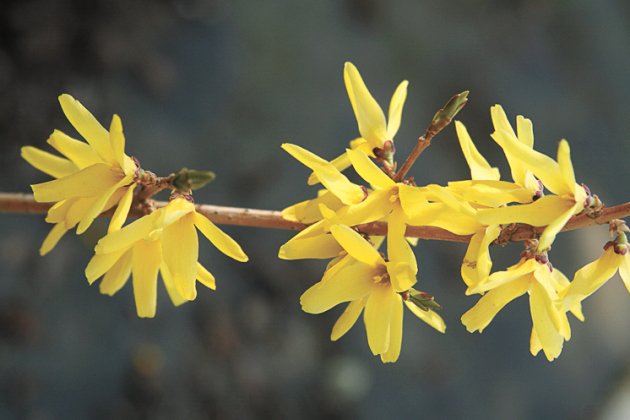
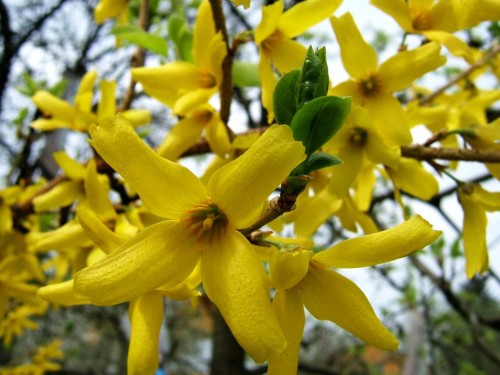
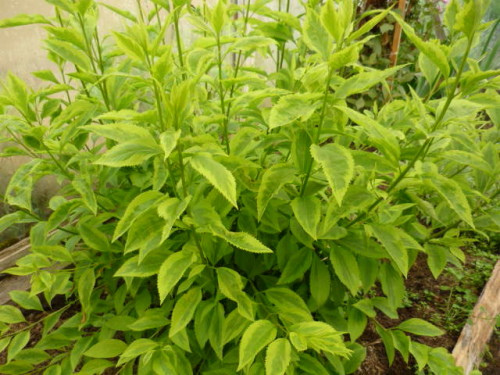
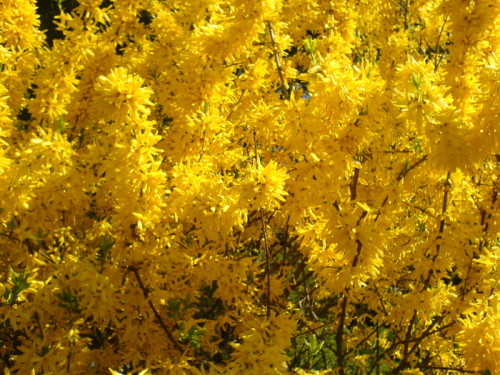
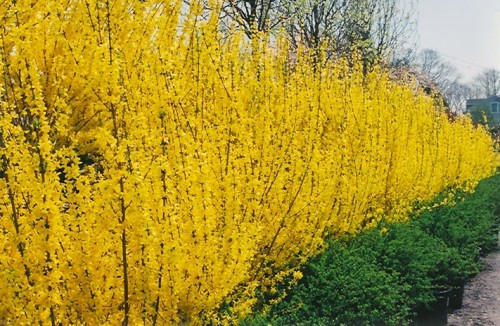
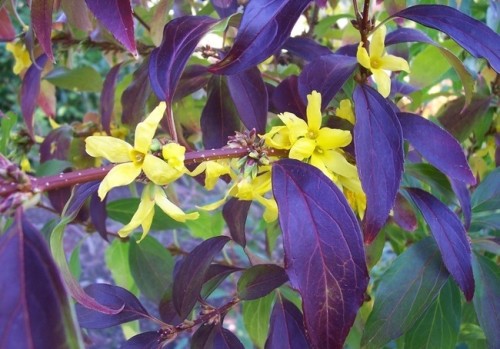

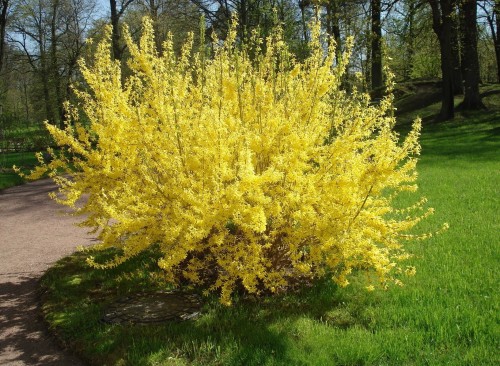
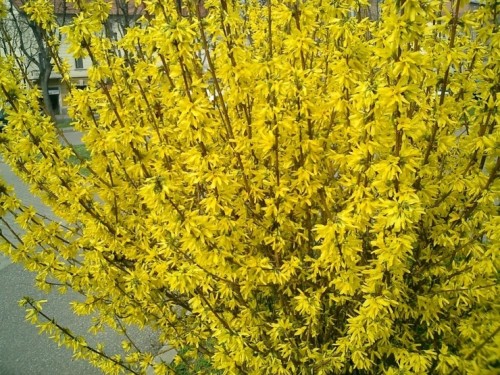
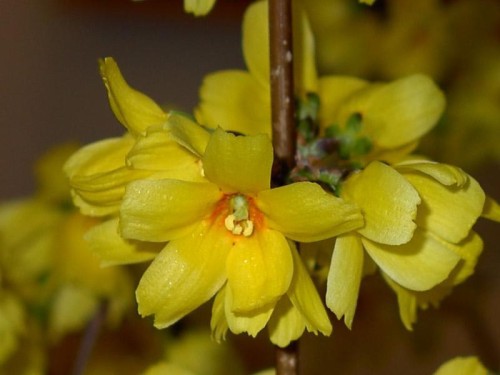
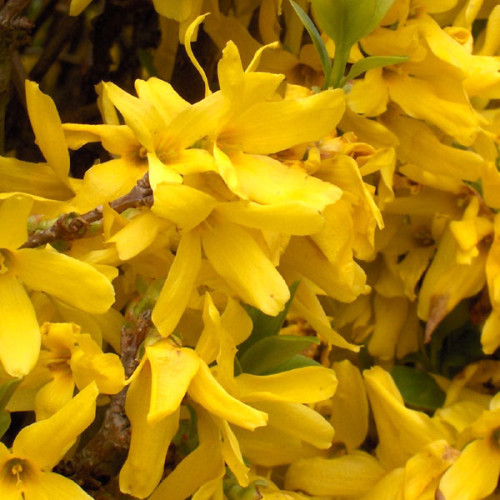
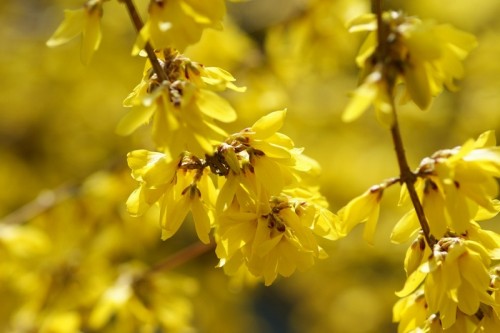
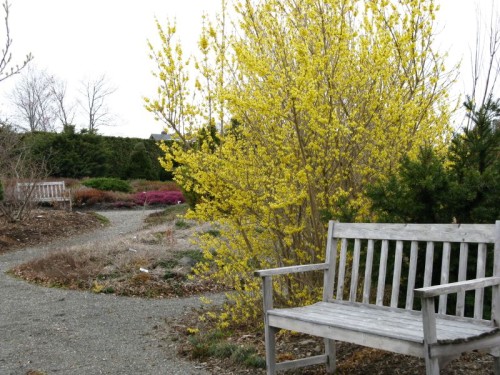
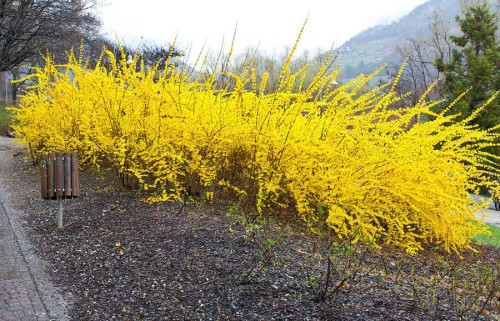
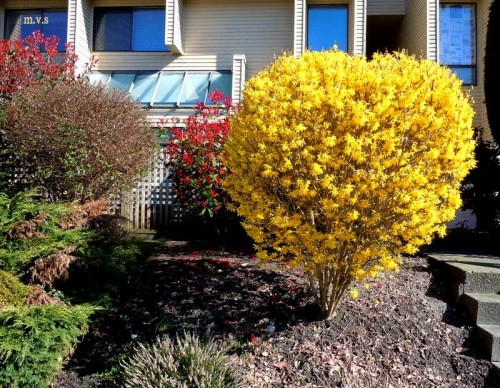
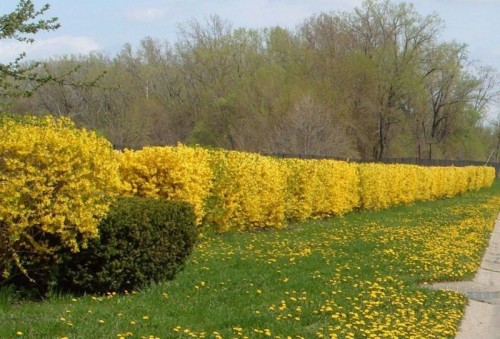












 Start a discussion ...
Start a discussion ...